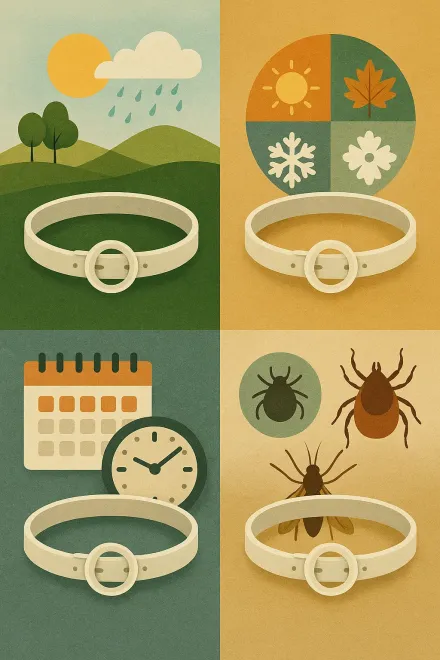Best months to put a flea collar on your dog
Using a flea collar should not be based solely on intuition, but on understanding when parasites are most active in your area. The activity of fleas, ticks, mosquitoes, and sandflies varies according to season, temperature, and humidity. While in warm climates the risk is almost constant, in many regions there are seasonal peaks that require reinforced protection.
Knowing the key months to place or replace the collar is essential to ensure your dog is protected before parasite activity begins, preventing infection or infestation.
See best-selling flea collars on Amazon
Factors that determine when to put a flea collar on your dog
There is no single date valid for all regions, as parasite activity depends on several factors:
- Climate: mild temperatures and high humidity favor parasite proliferation.
- Season: spring and summer are peak activity times, but in warm climates protection should be maintained year-round.
- Collar duration: some models protect for 4, 6, or 8 months, which affects placement planning.
- Type of predominant parasite: the calendar may vary depending on whether the main goal is to prevent fleas, ticks, or sandflies that transmit leishmaniasis.
Recommended calendar by season
In general, in temperate climates such as most of the Iberian Peninsula, this is the recommended schedule:
- Spring (March–May): put the collar on in early March so it’s active when parasite season begins.
- Summer (June–August): keep protection, as this is the highest-risk period, especially for fleas, ticks, and sandflies.
- Autumn (September–November): in warm areas, keep active protection until November to prevent late infestations.
- Winter (December–February): in cold regions the risk is low, but in coastal or warm areas year-round protection is advised.
In regions with mild winters, such as the Mediterranean, it’s safest to keep a flea collar on all year round.


Tips to plan collar replacement by month
Planning collar replacement properly is key to avoiding unprotected periods. Here are some tips:
- Put the collar on 7–10 days before the expected start of parasite season in your area.
- If using a 6-month collar, plan two replacements a year: March and September.
- If using an 8-month collar, a single replacement in early March covers the whole risk cycle.
- In warm or humid areas, keep the collar on year-round and replace it when its duration ends.
- Mark the installation date on a calendar to avoid forgetting replacements.
With proper organization, you’ll avoid vulnerable periods where your dog could be exposed.
Frequently asked questions about when to use flea collars
What month should I put on a flea collar?
In temperate climates, early March is ideal to cover the whole spring and summer season. In warm or humid areas, it’s best to keep it on year-round.
Is it necessary in winter?
In cold areas, winter risk is low and some owners remove it. However, in coastal or southern areas where parasites remain active, keeping it on is recommended.
Can it be used year-round?
Yes, especially in regions with mild or warm climates. This ensures there are no gaps in protection.
When should I put the collar on to prevent leishmaniasis?
Sandflies, which transmit leishmaniasis, are most active from May to October. Place the collar in late April or early May for protection from the start.
What if I put the collar on late?
If placed after parasite activity begins, your dog may already have been exposed, and in the case of leishmaniasis or Lyme disease, infection may have occurred.
Should I combine the collar with other methods?
In high-risk areas, it’s advisable to combine it with spot-on treatments or repellent sprays under veterinary supervision for added protection.
